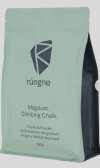schurgerdc
Level 6 Valued Member
I recently picked up some rosin free liquid chalk, commonly used by the climbing community. I was low and it was easily available at a good price so I said give it a try. The reason the climbing community use it is so there isn't a ton of chalk residue on the rock, i.e. preserving nature. I use liquid chalk regularly, and maybe 1-2x/mo I need to really clean off the accumulation of junk on the handles (really common on KBKings bells, less on my IronWarriors). What's most interesting so far is this rosin free brand seems to be staying on my hands longer (less reapplications thru Giant right now, bearing in mind I grip heavy throughout). Curious if anyone else has compared the different types.
Funny aside for people who wonder why you need chalk, I was in Fayetteville for a weekend, working on Giant 1.0 with my 20's & forgot to pack chalk. Without chalk, I was going to have hamburger hands. I found a store that had liquid chalk, and sure enough, also had 48kg bell there. I was working towards Sinister with a 44, and felt like I could probably swing the Beast 1-handed. Shop owner gave me the green light, and I went for it...got a good swing started. The finish on this bell was less aggressive than I would have liked, and lets just say I should have chalked up!! Thankfully the bell just flew into a rubbermaid cart with nothing on it to no damage!! Chalk up comrades, you may not be as lucky!!
Funny aside for people who wonder why you need chalk, I was in Fayetteville for a weekend, working on Giant 1.0 with my 20's & forgot to pack chalk. Without chalk, I was going to have hamburger hands. I found a store that had liquid chalk, and sure enough, also had 48kg bell there. I was working towards Sinister with a 44, and felt like I could probably swing the Beast 1-handed. Shop owner gave me the green light, and I went for it...got a good swing started. The finish on this bell was less aggressive than I would have liked, and lets just say I should have chalked up!! Thankfully the bell just flew into a rubbermaid cart with nothing on it to no damage!! Chalk up comrades, you may not be as lucky!!

